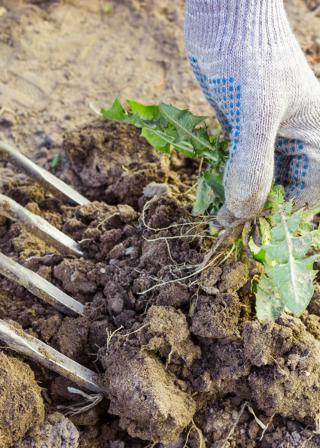A weed is defined as a plant growing where it is not wanted and is competing with cultivated plants for water, light and mineral nutrients. Weed management in landscape plantings can be complicated because the landscaped area is usually a mix of annual and perennial ornamentals. Weeds, like other garden pests, are best managed using multiple strategies. These may include prevention, mechanical or cultural practices, and herbicides. Following the steps below should provide you with the highest level of success in managing weeds. This approach is called integrated pest management which is often abbreviated IPM.
Weeds

Question:
There are two weeds that grow on my property that produce burrs. One is clover like and the other is a grass. They stick to clothing, blankets and animal flesh including my own! What are they? I spray them with herbicide but they reappear. How can I control them?
Answer
The two plants that are producing burrs in your yard are bur clover, Medicago hispida Gaertn., and field sandbur, Cenchrus pauciflorus Benth., which is a grass. Both of these plants are annuals and sometimes short-lived perennials reproducing from seeds. Bur clover is a low trailing plant found in lawns, gardens and along roadways and waste areas. Plants stem weakly, branching from the base and radiating out from a taproot one quarter to two feet long. Leaves are composed of three lobed clover-like leaflets with toothed edges and indented tips. Where the leaf joins the stem there is a pair of small leaf-like structures. Yellow flowers are produced during early spring and late fall. Seeds are found in spiny pods. The pods are straw colored or brown when mature and contain several kidney shaped seeds which are yellowish or tan colored. Bur clover should not be confused with another weed of the same genus called black medic, Medicago lupulina L., which is very similar but has hair, not spines on the seed pods. Both are natives of eastern Europe and Asia and are cousins of alfalfa. Field sandbur, Cenchrus echinatus L., is a warm season grass found in dry, sandy, cultivated soils in lawns, roadsides, washes and waste places. Plants are from eight inches to three feet tall with shallow roots which spreads horizontally forming mats. Leaf blades are flat, but can be twisted or folded and are two to five inches long. Reproduction is by seed or by prostrate stems that root. Burs grow in spikes one to three inches long and bear 10 to 30 burs each that are a shiny straw yellow that contain two seeds. Each plant can produce up to 1,000 seed.
These annual weeds arising primarily from seeds. Cultivation of young and/or mulching before seeds germinate can control these plants. On non-crop land soil solarization, using black plastic, can kill weed seed. Control with herbicides like Roundup or 2,4-D is best accomplished on young plants. Herbicides or cultivation of mature plants will not control these weeds in the long run if seeds are allowed to mature. If seeds are allowed to develop then chemical controls must applied before seeds germinate. Bur clover germinates during the cool weather of early spring or fall. Sand bur germinates during the warm weather of spring or summer. Herbicides that can be applied before seeds germinate are Gallery, which controls broadleaf weeds like bur clover or Surflan would be a second but not as effective choice. Field sand bur growing among broadleaf plants can be controlled using Poast or Fusilade. On non-crop land several compounds can be used including Stomp, Bueno or other soil sterilants. Some of these compounds are only available to pesticide applicators. As with all pesticides read the label and understand their use.
Arizona Ranch, Farm, and Garden Weeds

